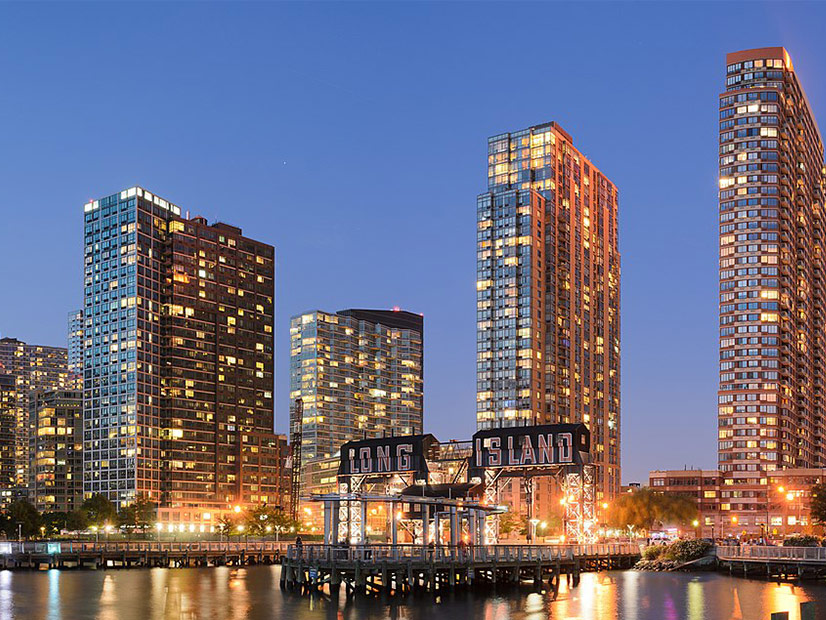
New York’s environmental regulatory authority is seeking input on permits for two natural gas-fired power station proposals that it says “appear” inconsistent with the state’s climate law.
The New York Department of Environmental Conservation (DEC) released draft permits for the 536 MW Danskammer Energy Center and 437 MW Astoria replacement project and requested public comment by Aug. 29.
“The climate crisis is one of New York’s top priorities,” Commissioner Basil Seggos said on Twitter Wednesday, adding that while there is no final determination on the permits, “DEC found that the current applications haven’t justified the projects or shown compliance with New York’s climate law.”
Opponents of both projects say the facilities are unnecessary and do not align with New York’s emissions requirements.
In March, Rep. Alexandria Ocasio-Cortez joined eight other Democratic U.S. representatives for New York asking Gov. Andrew Cuomo and DEC to consider green infrastructure as an alternative to the Astoria project.
“Moving forward with the implementation of new natural gas-fired power creates nuisances and real health hazards, which the community has vocally opposed,” the legislators said in a letter. “Frontline and diverse communities, like the ones we represent, stand to be disproportionately exposed.”
The Astoria facility is located adjacent to an area of the Bronx that is colloquially known as “Asthma Alley.”
In notices for both projects’ draft permits, DEC said that there are potential substantial GHG emissions associated with the proposed facilities.
“Based on the information currently available, it appears that the proposed [projects] would be inconsistent with or would interfere with the attainment of the statewide GHG emission limits established in the [Climate Leadership and Community Protection Act],” DEC said.
If a proposed project is inconsistent with the law, DEC must justify the project and identify alternatives or GHG mitigation measures.
DEC said it cannot satisfy either requirement without further input.
“We understand [DEC] has not made a final determination related to the [Astoria] project’s consistency with the [CLCPA]; however, as outlined in the project’s draft environmental impact statement, the project is estimated to reduce statewide greenhouse gas emissions by more than five million tons through the year 2035,” David Schrader, senior manager for communications east at NRG Energy, said in an email to NetZero Insider. “In addition, as a long duration backup/standby unit, the project facilitates the reliable interconnection of large amounts of intermittent renewable energy as required by the CLCPA.”
Danskammer Energy believes its upgrade project is “fully consistent with the CLCPA,” according to Michelle Hook, vice president of public affairs.
“Our repowering would replace a 70-year-old power plant with a highly efficient unit that will result in a reduction in statewide greenhouse gas emissions,” she in an email to NetZero Insider. “The new unit would displace not only our own existing power plant, but also other regional electric generation units that emit significantly more greenhouse gases.”
Proposals
As proposed, the Danskammer Energy Center project would replace gas-fired/oil-fired generators at the existing Danskammer station in Newburgh, N.Y., with a gas-fired/ultra-low sulfur diesel (ULSD)-fired combined cycle generator.
“The events of the last few days, during which New York City residents received emergency alerts to reduce power usage, illustrate the continued need for new, reliable power to support and back up our growing renewable grid,” Hook said. “Danskammer believes the issuance of our draft permit recognizes the need for New York to work together with power generators towards achieving its climate goals.”
Hook said the company looks forward to working with NYSDEC on appropriate mitigation measures to move the project forward.
NRG’s proposed Astoria station upgrade in Queens would replace natural-gas and oil-fired combustion turbines with one natural gas-fired/ULSD-fired simple-cycle generator.
In 2010, NRG proposed replacing the existing units with a 1,040-MW facility but modified the proposal last year to 437 MW.
The company is “pleased” with DEC’s decision to issue the draft permits and deem the project application complete, Schrader said.
“This is an important step in securing an affordable and reliable future electric system for New York City,” he said. “As the last few days demonstrated, the need for reliable power is as great as ever and will continue for years to come.” Modernizing the generating station, he added, “ensures that schools, hospitals and homes are powered more efficiently and with dramatically lower emissions.”
NRG expects to begin construction as soon as the permits are finalized, Schrader said, adding that the project will bring more than 500 new jobs to Queens.
“We remain grateful for the ongoing support of our neighbors, labor and trade unions, business leaders and community groups,” he said.
NRG, he added, is looking forward to receiving public input on the project and “working with DEC to ensure the project is consistent with New York State’s aggressive climate goals.”
DEC plans to hold a public hearing for the draft permits in the “near future.”


